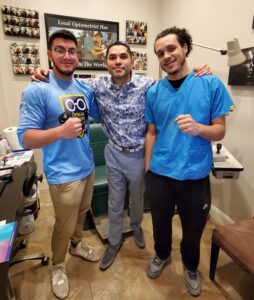
Dr Mena, center, with members of his practice team. Dr. Mena says a simple word change when working with patients can make a significant difference to compliance with treatment plans and likelihood to make a purchase.
The huge impact of a small change in words.
By Vittorio Mena, OD, MS
Feb. 21, 2024
When talking to your patients, a slight change in how you express yourself can make a significant difference to treatment-plan compliance and product sales in your optical. Here are a couple words I now make sure I use whenever working with patients.
“Because”
When it comes to the psychology of sales, “because” imparts influence and persuasion. In a June 1978 experiment, Harvard social psychologist Ellen Langer asked college students waiting in line to use a Xerox photocopier if she could cut in front of them. She used three different phrases to see which would be most persuasive.
The most successful phrase was: “I have five pages, may I use the Xerox machine because I am in a rush?” The request with a true reason (a “because”) associated with it resulted in a 94 percent success rate of skipping ahead in the line. She tried this again a different time using a request-only phrase: “Excuse me, I have five pages, may I use the Xerox machine? The request with no “because” only led to a 60 percent success rate of skipping ahead in the line.
The last phrase she used was: “Excuse me, I have five pages, may I use the Xerox machine because I have to make copies.” If you think about this logically, everyone who is waiting in line is also there to make copies, but, even so, adding the word “because” into the mix led to a 93 percent success rate of skipping the line.
The take-home message is to use the power of “because” in the exam room, and to train your opticians to use it in the optical.
For example: “I am prescribing a second pair of prescription sunglasses because you told me you do a lot of outdoor activities.”
“I am prescribing this supplement because you told me your family member has a history of AMD.”
“I am prescribing contact lenses or prescription sports goggles because you play sports on a team and this will help you track the ball better or minimize eye injuries”
Using the word “because” forces you to explain the reason behind your prescription or directions. When you do this, people tend to respond more positively. It is only natural to appreciate being given a genuine, sincere explanation for why you want them to do things. Explaining the reason behind “because” leads to better patient compliance and greater sales of products.
“Prescribe”
The most powerful thing we have as doctors is the power of prescribing.
Note previously that I said I am prescribing a second pair of prescription sunglasses and I am prescribing supplementation. The words “prescribe” and “recommend” sound similar, but they have different connotations. When you recommend something, it sounds like you are leaving it up to the patient to decide whether they should or should not do what you are instructing them to do.
Other Articles to Explore
However, if you prescribe something, it comes across to the patient as an expert in the field telling them they must do something for the sake of their vision or eye health. The chances of the patient complying are now higher.
It’s important that you couple the use of “prescribe” with “because.” Researchers found that “among more than 75,000 Massachusetts patients given drug prescriptions over one year, 22 percent of prescriptions were never filled. The rate was an even higher 28 percent when the researchers looked only at first-time prescriptions.
Also, according to a paper in the Journal of General Internal Medicine, “…28-31 percent of new prescriptions for diabetes, high blood pressure and high cholesterol went unfilled. Dr. Michael Fischer stated, “If a patient does not fully understand the reason that they are being prescribed the medication, they may be less likely to take it.”1
We do not have data specifically on patients filling their eye drops or ophthalmic oral medications, but we can assume that they are more likely to fill it if their eye is in pain and are looking for immediate treatment due to discomfort.We would have to explain that we are prescribing the medication because it is beneficial to their eye health and will make them feel much more comfortable, lessening their pain.
Results: In the end, we try our best to care for our patients and give it 100 percent of our effort. Be more conscious of using the words “prescribe” and “because” inside and outside the exam room. Doing so will lead to more compliance and success for both the patient and practice.
Before instituting this word change, capture rate on products in our practice was around 65 percent, and after making this change, it rose to 85-90 percent ! Give it a try, and see what it does for your patients and practice!
Reference
1. Feb. 2010, Reuters
 Vittorio Mena OD, MS, is the sports vision director with Optical Academy. To contact him: menavitt@gmail.com
Vittorio Mena OD, MS, is the sports vision director with Optical Academy. To contact him: menavitt@gmail.com

























